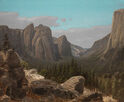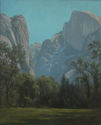
19th, 20th & 21st Century Fine Prints
707-546-7352 · fax 707-546-7924 · web: www.annexgalleries.com · email: artannex@aol.com
James David Smillie Biography
James David Smillie
American
1833–1909
Biography
James David Smillie was born in New York City on January 16, 1833, the eldest son of Katharine van Valkenberg and James S. Smillie. His father, a noted engraver, had a major influence on nineteenth century American engraving and etching and is probably best known for his banknote engraving with Rawden, Wright and Hatch, and for his engravings after Thomas Cole's painting series, Voyage of Life.
James D. Smillie studied at the Poughkeepsie Collegiate School and later at the University of New York. It has also been noted that he studied at the National Academy of Design in New York. Young James learned the art of engraving from his father and when he was eight years old produced his first etching on copper, a visiting card plate. In January 1846, he tried his first attempt at composition with a watercolor of the fall of Satan after Milton’s poem, Paradise Lost. He was employed as a bank note engraver before he and his father started their own engraving business; they specialized in banknotes but also produced the engravings for the 1857 Mexican Boundary Survey Report.
James D. Smillie’s first etching is dated March 22, 1846, and his first published print dates to 1849. He continued in his profession as an engraver in steel and was hired in 1859 by the American Bank-Note Company. This same year he made his first creative or "free-hand" etching, which was portrait of Washington Irving.
After two years traveling in Europe, James D. Smillie returned to New York and took up landscape painting. His younger brother George, also an artist, had a studio in New York City and James rented a room in the same building located at 212 Fifth Avenue. He sought inspiration for his imagery in rural settings in New York State, including the Catskills and the Hudson Valley, eastern Pennsylvania, and western Massachusetts.
James D. Smillie exhibited in the spring exhibition of the National Academy of Design in 1864, and also exhibited at the Brooklyn Art Association, the Boston Athenaeum, the Artists Fund Society, the Metropolitan Sanitary Fair (to raise funds for the Union wounded), and the Yonkers Sanitary Fair. He was made an associate member of the National Academy of Design in 1865 and taught at the Academy in 1868.
In 1866, he co-founded the American Society of Painters in Water Colors (the American Water-Color Society), later serving as its president from 1873 to 1879. He was elected a full Academician in the National Academy of Design in 1876, and served as treasurer between 1894 and 1898.
The Smillie brothers had difficultly supporting themselves due to the sparse sales of their paintings and found it necessary to live with their parents. A gift from an uncle allowed the brothers to travel across the country in June of 1871 and live for the better part of four months in Yosemite. During that summer, James drew, painted, and wrote about the majestic splendor of Yosemite. In 1872, Picturesque America was published by D. Appleton and Company of New York. James D. wrote The Yosemite section based upon his journal entries and illustrated it with engravings after his drawings and paintings.
Even after Smillie turned toward painting and drawing, he continued to earn most of his income as an illustrative engraver. Within a few years, his fortune changed and, between 1874 and 1876, he was producing more than thirty-five paintings in watercolor and oil each year.
Smillie headed the watercolor committee for the Centennial International Exhibition of 1876. Held in Philadelphia, it was the first official World’s Fair held in the United States and was a celebration of America’s hundredth anniversary of independence. Smillie was elevated to full Academician in the National Academy of Design in 1876. As early as 1870, he attempted to interest fellow etchers in forming an etching club in New York but had no luck. In 1877, he co-founded the New York Etching Club and the first meeting was held in his studio. In 1881, he was elected as one of the “original fellows” of the London Society of Painter-Etchers.
James married Anna Clinch Cook in 1881. She was the daughter of a prominent New Yorker who was active in society and charitable affairs. Anna was thirty-seven at the time of her wedding and was wealthy enough to purchase a row house on East 38th Street in New York. Their marriage resulted in two sons, James Cook Smillie and Ralph Ireland Smillie.
The marriage to Anna relieved James of the strain of producing an income and he returned to the medium of etching and several of his etchings were illustrated in the American Art Review and Poets and Etchers. Between 1888 and 1896, he produced a body of very painterly florals in drypoint, mezzotint, and roulette. In 1894, he conducted the first etching class at the National Academy of Design and continued to teach there until 1903. Anna suddenly died in 1895 and the artist found himself raising two sons. He moved his studio again, this time to a former stable in Sniffen Court, an alleyway at 156 E. 36th Street. The summerhouse in Montrose that was designed by Anna’s brother was sold in 1900.
Smillie’s last years were spent traveling and working as a consultant to Frank Weitenkampf, head of the New York Public Library Art Department, in designing print storage at the new Fifth Avenue New York Public Library. Smillie donated his father’s engravings and his own etchings to the library’s collection. Besides the New York Public Library, his works are represented in the collections of the Amon Carter Museum, Boston Museum of Fine Art, Carnegie Library, Metropolitan Museum of Art, National Gallery of Art, Oakland Museum of California, and the Pennsylvania Academy of Fine Art.
James David Smillie died on September 14, 1909, in New York City. A memorial exhibition was held in 1910 at the New York Century Club.
Sources:
There are publications regarding Smillie’s creative printmaking: a catalogue raisonné by Brucia Witthoft, ISBN 0-7734-9520-7; an exhibition catalogue with an extensive checklist by Michael Schantz for the Woodmere Museum in Philadelphia in 1991; Michael Schantz’s 2010 article ‘“A Joy to the Eye:” The Floral Prints of James D. Smillie’ published in Imprint, journal of the American Historical Print Collectors Society.







